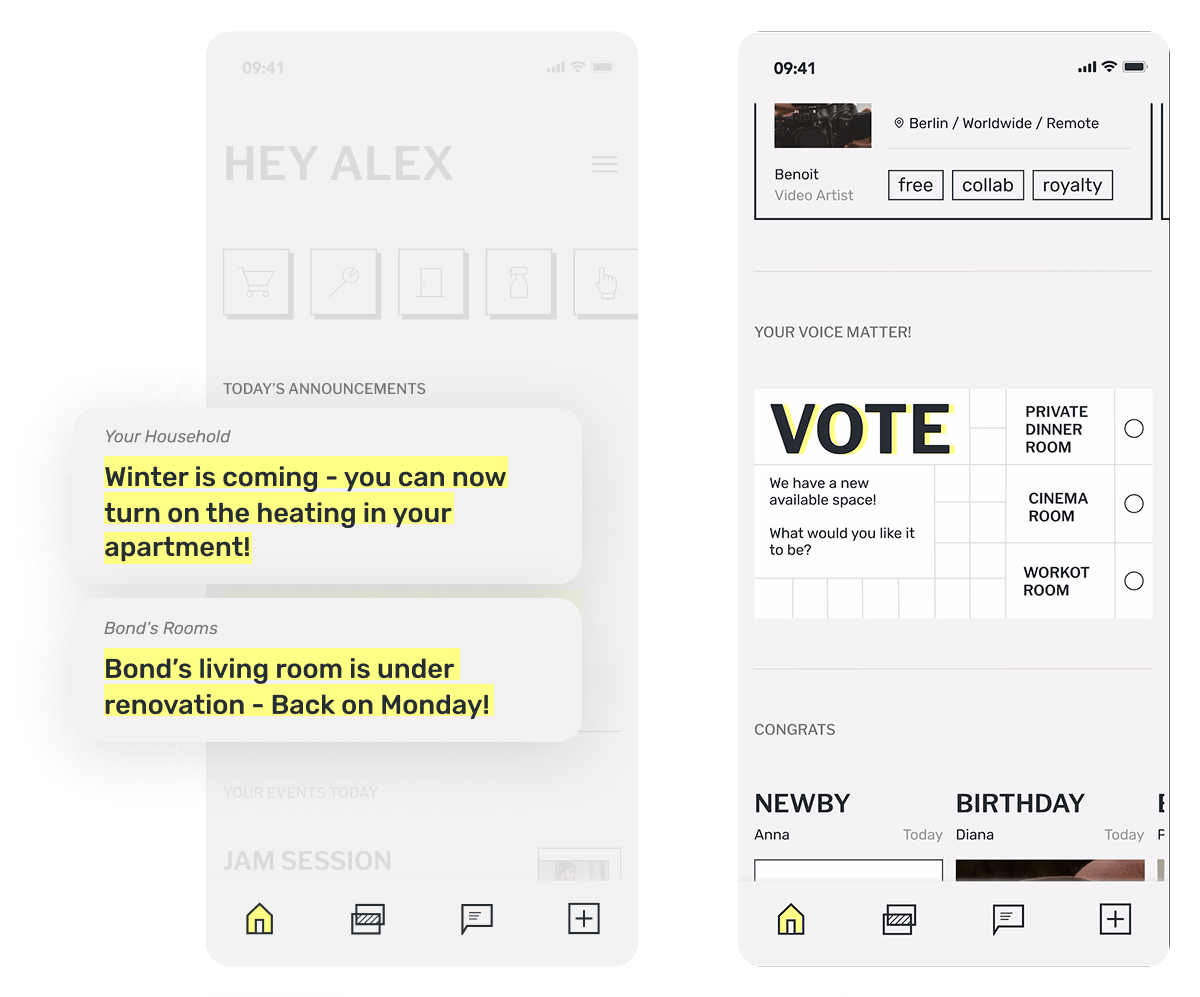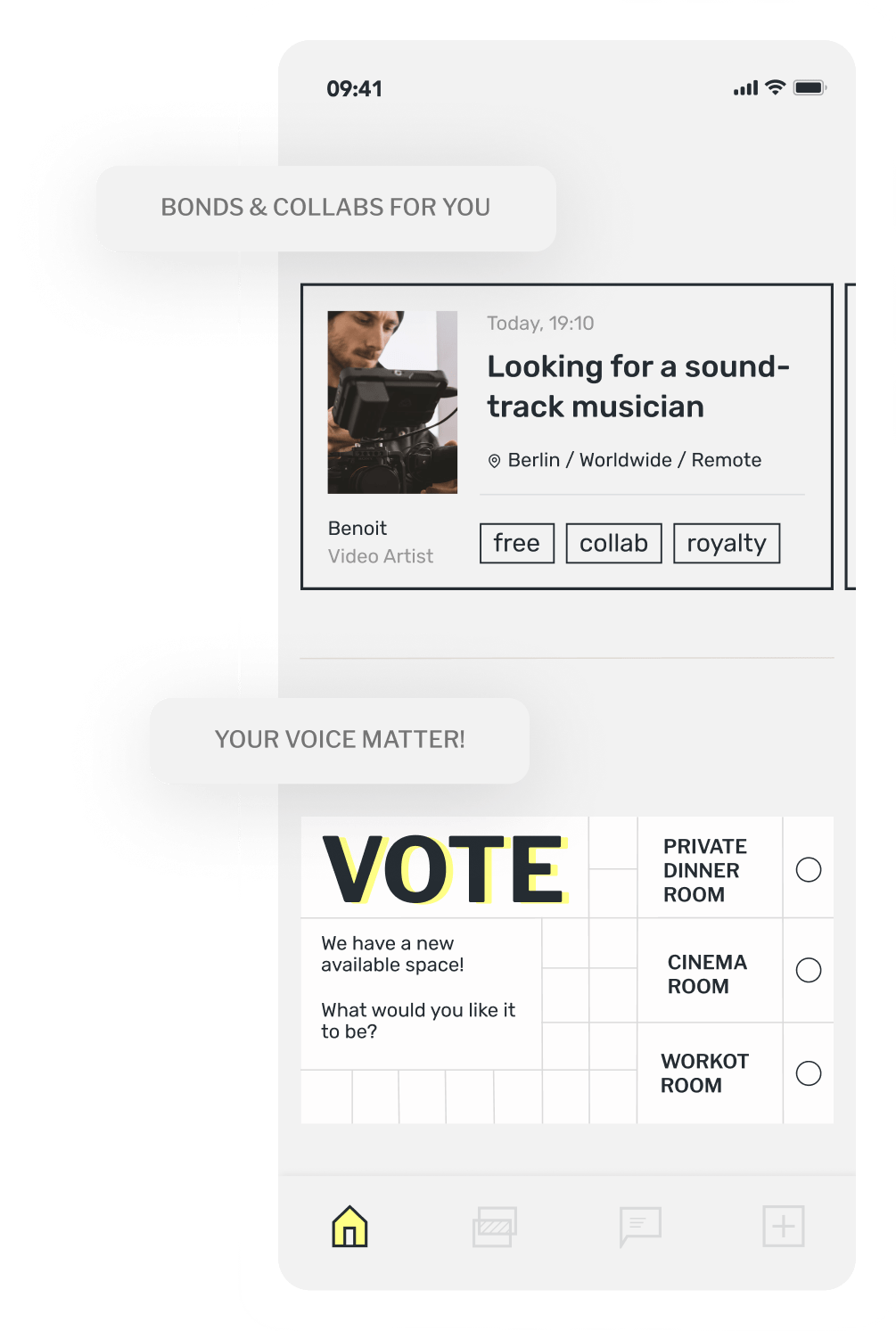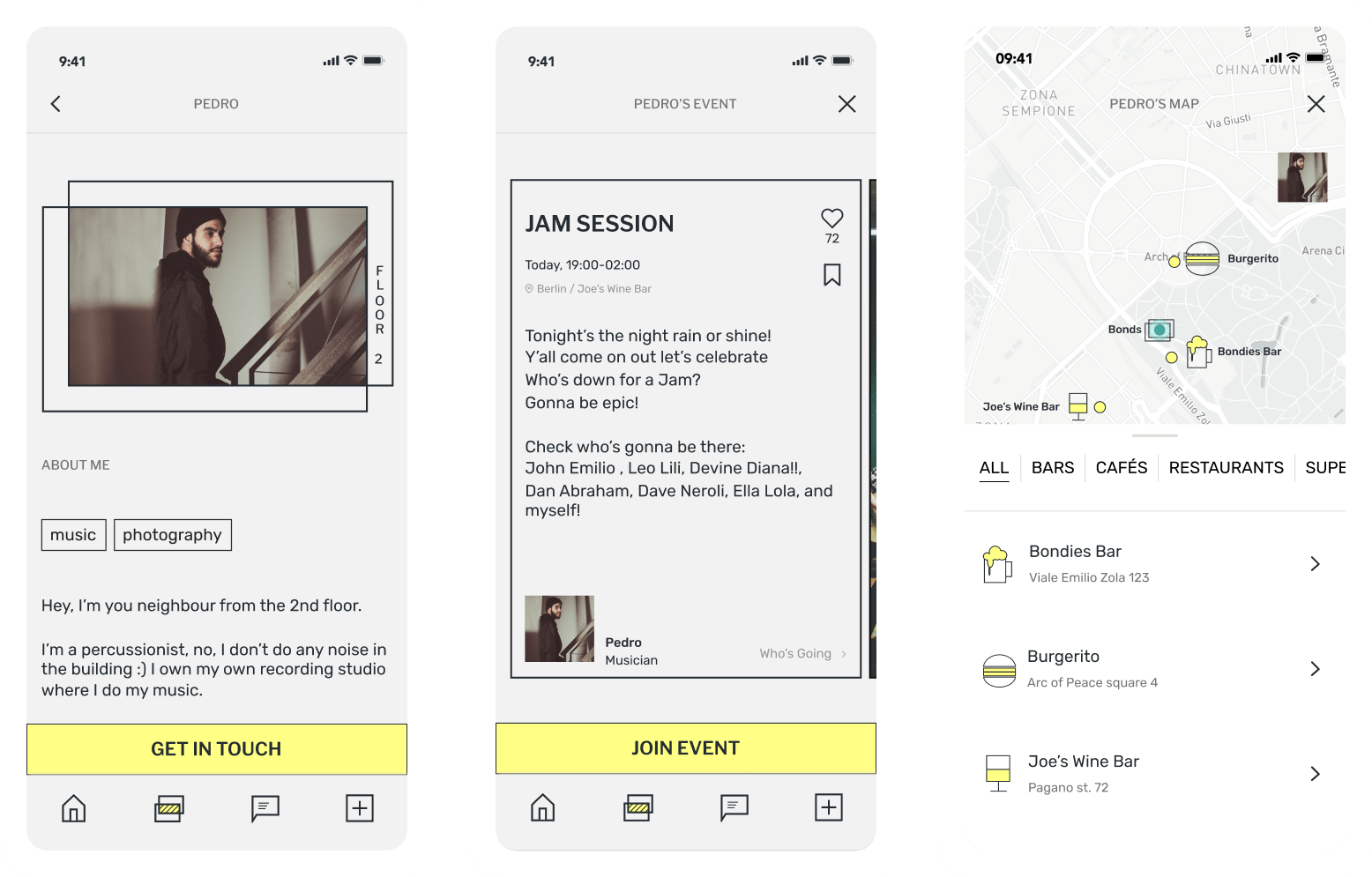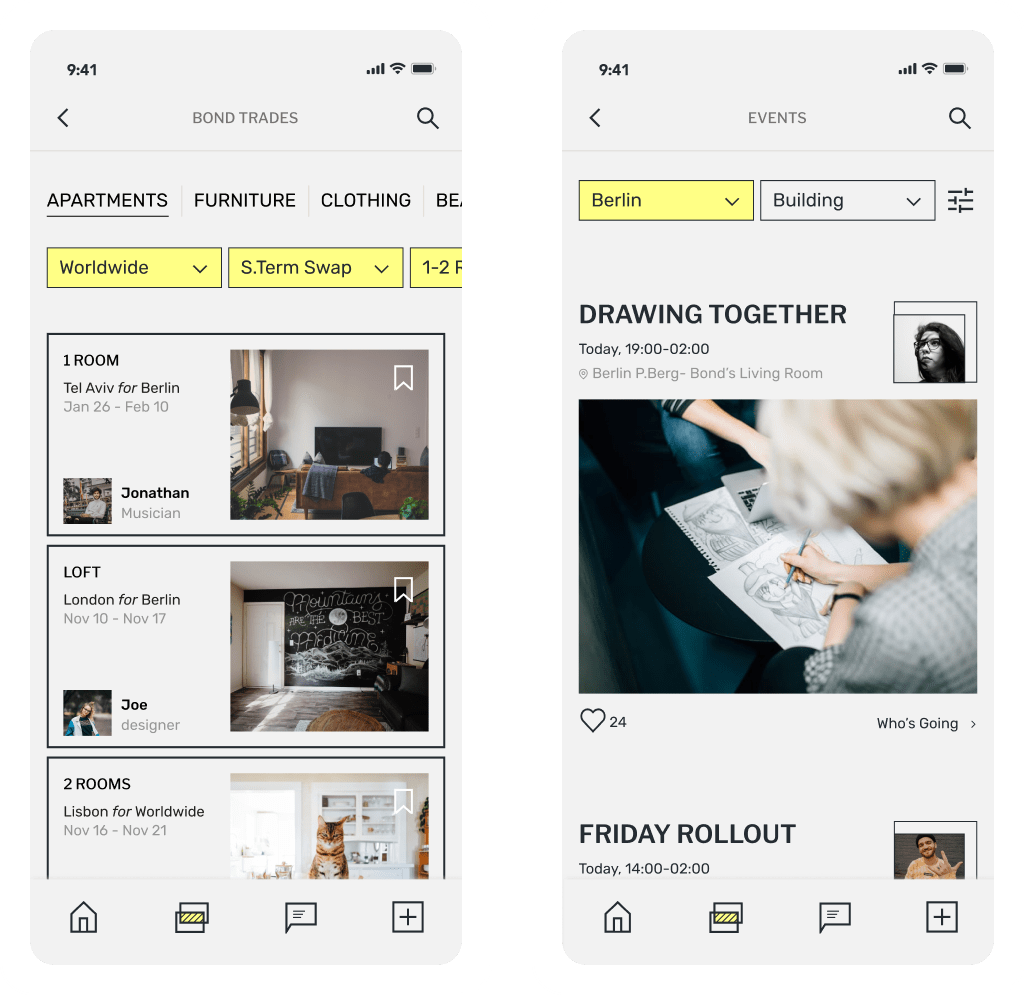Coliving App
Product Design for a Scaling Industry
Info
About
With a background in Product Design and a passion for community-building, I sought to design a product that would provide real value to coliving tenants and operators, addressing both their needs within one comprehensive platform. This project also offered an opportunity to go beyond traditional digital design, exploring how to translate the physical and emotional experience of community into a seamless digital interaction. Bridging these dimensions was essential to creating a product that truly enhances the coliving experience.
What
I designed a tenant-centric app for the coliving ecosystem, focusing on helping tenants connect with both local and global communities, manage household services, and address security concerns. This app is part of a broader B2B2C concept where both coliving operators (businesses) and tenants (consumers) benefit from a unified platform. The case study here presents the main concept of the tenants’ side of the app, though the overall design also serves operators by streamlining communication and operations.
Why
Coliving tenants often face fragmented experiences, relying on multiple platforms (e.g. WhatsApp, email, independent booking tools) to manage household tasks, coordinate with neighbors, and participate in community activities.
Operators, too, face challenges managing communication, service requests, and tenant engagement across different platforms. There was a clear need for a unified platform that not only simplifies household management but also promotes meaningful social connections and community engagement.
Rethinking Bonds: Designing for the Scale of Coliving
As urban living continues to evolve, coliving is emerging as a compelling alternative, driven by the desire for stronger community connections and more efficient living arrangements.
This case study explores the potential of coliving as a new way of living, where technology and design intersect to create spaces that foster both personal and community growth.
By examining the challenges and opportunities within this expanding industry, this project seeks to reimagine how global and local communities can thrive together.
Research
To create a meaningful and effective coliving app, I applied a comprehensive research approach.
This included attending industry events, conducting expert and tenant interviews, and analyzing current coliving platforms to understand both opportunities and gaps within the market.
Exploring the Coliving Ecosystem: A Market Research Journey
To design an app that effectively addresses the needs of coliving tenants and operators, I embarked on a comprehensive research journey into the coliving ecosystem. This involved not only studying existing digital tools but also immersing myself in the coliving community and interacting with professionals in the industry.
Understanding the Landscape & Competitor analysis
I began by reviewing the current state of the coliving market, analyzing the platforms and services that tenants and operators rely on. This included digital tools for household management, community interaction, and daily living.
Participating in the Coliving Community
In addition to competitor analysis, I actively engaged with the industry by attending weekly coliving professionals’ meetups. These sessions offered valuable insights into the challenges and opportunities faced by coliving operators. Conversations with industry specialists provided a real-world perspective on the operational hurdles and the evolving needs of tenants.
Operators and Community Managers Interviews
Alongside tenant interviews, I conducted discussions with coliving operators and community managers to uncover the operational challenges they face in maintaining effective communication, managing service requests, and building a cohesive community. These insights provided a clearer view of the complexities in balancing tenant needs with efficient operations.
Engaging with Experts
I also conducted interviews with coliving specialists who had lived in multiple coliving spaces worldwide. Their feedback highlighted critical areas, such as the need for seamless integration between physical and digital spaces and the importance of fostering authentic community interactions while maintaining tenant privacy.
Literature Analysis on Coliving Trends and Challenges
I conducted an in-depth analysis of existing researches on coliving trends and challenges, including industry reports, annual reviews, and case studies. This analysis incorporated data and insights from coliving companies’ research, such as tenant interviews and feedback surveys. These resources offered valuable perspectives on community-building, privacy expectations, tenant-operator dynamics, and operational challenges.
These interactions, all together, formed a vital part of the research, offering a grounded understanding of how the coliving ecosystem operates.
Urban Insights: Designing for Connection
To better understand how spaces foster community, I explored urban design principles, including proxemics-the study of how spatial arrangements influence human interaction.
Insights from William H. Whyte and Jan Gehl highlighted how shared environments encourage social interactions. Whyte’s observations on narrow spaces fostering spontaneous connections and Gehl’s focus on prioritizing human experiences in communal design were particularly valuable.
This research deepened my understanding of how physical design principles shape human interactions, offering a foundation for exploring similar dynamics in digital spaces.
Understanding Tenants’ Experiences: Users Interviews
To gain a clearer picture of tenant experiences in coliving environments, I conducted interviews with residents from a range of locations and backgrounds. These conversations revealed recurring themes about how tenants navigate daily life within coliving spaces, their expectations around community engagement, and their interactions with available platforms.
These discussions provided essential insights into tenants’ day-to-day challenges and highlighted the aspects of coliving that they felt could enhance or simplify their lives. The feedback revealed both the appeal of coliving and areas where a more streamlined, supportive app could add value by fostering community connections and managing practical needs.
Key Findings
Fragmented Tenant Experience Across Platforms
Tenants currently rely on a mix of digital tools (WhatsApp, email, booking systems) for managing daily tasks, community events, and social interactions.
This fragmented approach results in a disjointed experience, detracting from the seamless, cohesive lifestyle that coliving aims to provide
New Tenant Integration and Exploration
Privacy vs. Community Balance is Critical
Tenants appreciated the sense of community but emphasized the importance of private spaces for personal downtime and boundaries.
Main Insights
Community-Driven Engagement and Resource Sharing
Community-driven initiatives could enrich the collective experience and deepen each member’s personal sense of belonging, while helping operators create valuable, empowered spaces. This valuable content driven by the community could offer operators a strengthened community foundation.
Why it’s important
Research in community psychology shows that community-driven engagement positively impacts members’ sense of belonging and loyalty. Studies indicate that when individuals feel a sense of ownership and influence within their community, they are more likely to stay engaged and invested.
Beyond organized events, a vibrant community empowers tenants to feel connected and take an active role in shaping their environment. This dynamic fosters deeper connections and personal investment in the community. For coliving operators, embracing tenant-driven content and participation can significantly enhance tenant satisfaction, creating a more resilient and invested community
Beyond Community: Security, Support, Privacy, Independence
Why it’s important
1. Security in Shared Spaces:
Research demonstrates that a consistent sense of security significantly reduces stress and fosters trust within shared coliving environments, particularly in settings with close living quarters. This foundation of safety enables tenants to feel at ease and encourages a willingness to connect within the community.
2. Consistent Access to Essentials:
Studies in tenant satisfaction emphasize that dependable access to daily essentials—such as utilities, maintenance, and household services—is vital for resident well-being, peace of mind, and satisfaction. When primary needs are consistently met, tenants feel a greater sense of stability, which enhances their comfort within the coliving environment. This solid foundation encourages long-term tenancy.
Transparent Communication: The Foundation of Trust
Why it’s important
Effective communication strengthens trust and empowers residents to feel informed and engaged.
- Clarity Reduces Conflict: Regular updates about house rules, events, and maintenance prevent misunderstandings.
- Engagement Opportunities: Transparent communication encourages residents to participate in community events and initiatives.
- Trust Building: When management communicates openly, it creates a sense of accountability and reliability among residents, the feeling of being heard is essential in any community.
The Potential of a Global-Local Community
Why it’s important
Translating Urban Design to Digital Spaces: Design for Community and Connection
Why it’s important
- Proximity Encourages Interaction: Narrow pathways and shared spaces naturally spark casual encounters.
- Safety Fosters Trust: Open sightlines and active areas promote a secure and welcoming environment.
- Inviting Activities Promote Vibrancy: Thoughtfully designed spaces for optional and social activities attract and engage participants.
- Visibility Strengthens Belonging: Observing others participate fosters inclusion and encourages meaningful interactions.
The Need for Scalability in a Growing Product Ecosystem
Why it’s important
Suggested Solutions
Creating Bonds at Every Scale
“Bonds” is designed to adapt seamlessly to the varied scales of coliving- ranging from small, localized communities to expansive, international networks.
Grounded in research and urban design principles, the UX strategy emphasizes nurturing organic connections and empowering tenants to actively participate in their communities. The app aims to bridge the gap between the physical and digital, ensuring tenants are encouraged to connect and contribute, and operators can efficiently manage and engage with the community.
The UI design, inspired by architectural maps, leverages clean geometric shapes to create a structured yet adaptable framework. This approach emphasizes flexibility for white-label customization, allowing operators to align the product seamlessly with their brand identity. While maintaining this adaptability, the UI introduces a unique, playful, and sassy language tailored to young, vibrant tenants who form the core user base of coliving communities. Reflecting the concept of common spaces, where paths intersect and foster interaction, the design highlights shared areas that promote connection. By balancing clarity with personality, the UI ensures a cohesive and engaging experience across diverse coliving communities.
Building Trust Through Security and Transparent Operator Communication
Establishing trust is fundamental to any thriving community. In coliving, this trust extends to both the operational relationship with management and the interpersonal dynamics within the community. To achieve this, seamless communication, transparent tools, and visible activity are essential to fostering confidence and safety.

Accessible Essentials
Quick Action Buttons
These buttons provide quick access to critical services, such as operator communication, submitting requests, booking rooms, and reporting emergencies. By making essential features easily accessible, the platform instills trust and ensures tenants feel supported and secure.
Additionally, the platform’s white-label design offers flexibility, allowing providers to customize the buttons by adding, removing, or adjusting them to align with their unique offerings and services.
Emergency and First Aid Features
Dedicated emergency and first aid buttons are prominently displayed the top action bar, reinforcing a sense of safety.
Tenants can act quickly in urgent situations, providing reassurance that the platform prioritizes their well-being.
Transparency
Transparent Announcements and Operator Communication
A dedicated area for personal announcements and operator updates ensures tenants remain informed about anything that is important and relevant for them: house rules, events, personal orders and changes.
Transparent communication builds accountability and trust between tenants and operators.
voting tools
The voting feature empowers tenants to voice their preferences on community matters, such as event planning or shared decisions.
This collaborative tool strengthens trust and engagement by ensuring tenants feel heard and valued, creating a more democratic and inclusive community environmen
Home: A Space Tailored to the User
Balancing Personal and
Community Spaces
Research showed tenants value control over community interactions, preferring to engage on their own terms.
The homepage prioritizes personal relevance, displaying announcements, events, and collaborations based on tenant interests and activity. It serves as a private space first, while subtly opening paths to connection and supporting autonomy through organic participation.
Fostering Trust and Connection Within the Community
A vibrant coliving environment thrives on organic connections and active participation. Tenants seek opportunities to engage, contribute, and feel part of a larger, lively community.
Translating these needs into digital solutions involves balancing visibility, accessibility, and spontaneity.
Drawing inspiration from urban design principles, the platform mirrors the reassurance provided by active, vibrant spaces—where seeing others engaged fosters a sense of security and belonging, much like the natural flow of a well-designed city street.
Bond & Connect: A Dedicated Space for Community Engagement
The Bonds page serves as a central access point to key community-driven features—including Community, Events, Trades, Neighborhood Insights, and News.
Its layout, influenced by architectural plans and the connection and intersection between elements, visually reinforces the idea of coliving as a network of interconnected spaces, where every part contributes to the larger community experience.
Bottom Menu
At the heart of the platform’s bottom menu lies the + button, a symbol of empowerment for tenant-driven initiatives. This feature allows tenants to create events, share announcements, and propose collaborations seamlessly.
By making content creation accessible and intuitive, the “+” button encourages tenants to take ownership of their community experience, fostering organic connections and ensuring a dynamic, tenant-led environment.
Community-Generated Content
Tenant-created activities like meetups, workshops, and collaborations foster ownership and strengthen community bonds.
Visibility into organizers and participants encourages engagement, inspiring interaction and reinforcing the community’s vibrancy.
This approach empowers tenants to shape their environment while reducing reliance on operator-led initiatives.

Getting to Know the Community
Tenant’s Profiles
Tenant profiles allow users to discover their neighbors, fostering connections both within the platform and in real life.
Privacy is prioritized—only first names are displayed by default.
Tenants have full control over what they share, content is user-generated and optional but thoughtfully designed to encourage relevant details that facilitate meaningful interactions.
Users’ activities are automatically reflected in their profiles, showcasing their involvement in the community.
Exploring the Area Through Recommendations
Personalized maps created, enriched with tenant recommendations, offer users a curated way to discover local spots and community activities.
Combined with tenant profiles, these tools help newcomers integrate into the community more easily, fostering a sense of trust and security by showcasing an active, engaged environment.
Profiles and Maps: Tools for Integration
By bridging digital and physical experiences, these features create opportunities for connection, exploration, and interaction, reinforcing trust and connection within the community.
Congrats Notifications
Scaling Connection Across Local and Expanding Communities
Understanding that a community is not limited to a building or a specific location, the platform leverages the potential of coliving to connect local and broader networks. As coliving grows, whether within a country or internationally, the opportunity to create a unified, expansive community emerges. Recognizing this potential, the platform is designed to help tenants integrate into their immediate environment while fostering meaningful connections across the larger coliving network.
Global Collaboration
The Community page allows tenants to search by location or interests, fostering relevant connections and enabling meaningful collaborations across local and international networks.
Features like “collab cards” open doors for projects and exchanges that connect tenants globally, supporting a dynamic, evolving community.
Bonds’ Trades Page
The Bonds Trades Page showcases the unique value of a global coliving community.
Beyond local exchanges, it offers opportunities like sublets, swaps, and shared resources across locations. This aligns with tenants’ exploratory nature and mobility, empowering them to independently explore options within the coliving ecosystem.
For operators, this feature helps retain tenants by keeping them engaged within the system even as they travel or relocate, fostering loyalty and a sense of belonging to the larger network.
Vision & Impact
This project reflects my entrepreneurial initiative and passion for exploring how design can bridge digital platforms with real-world interactions.
Driven by the desire to foster authentic connections and support community-building, the platform was designed with tenants at its core, empowering them to engage meaningfully with their community while simplifying daily interactions.
At the same time, it was envisioned to enable coliving operators of all scales, from small businesses to international networks, to create thriving communities. By providing a flexible, white-label solution, the platform allows smaller operators to deliver a tenant-focused experience without the need for custom-built systems, while offering scalability to grow alongside their business as it evolves.
While the project remains paused at this stage, I chose to showcase it because it represents my deep interest in creating meaningful, impactful experiences that extend beyond the screen and into daily life.
Sharing this case study reflects my belief in the value of contributing ideas and insights to broader conversations across industries, including coliving. During my research, the interest shown by industry professionals underscored the relevance of these solutions and their potential value within the coliving sector. Through this case study, I aim to highlight the solutions developed and inspire discussions on how thoughtful design can elevate this evolving field, offering impactful tools for connection, growth, and innovation.
© 2024, Aviya Serfaty | Built by David Gershon

